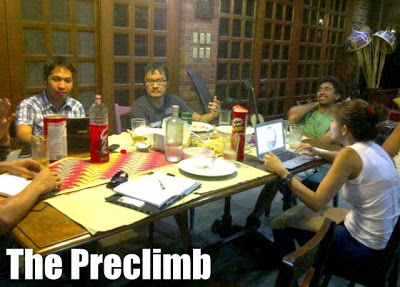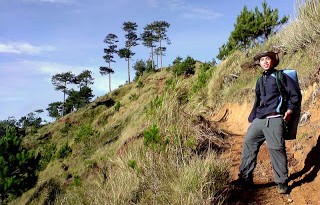Climb Preparation: The Preclimb
by Gideon Lasco
First edition, June 13, 2012
A preclimb meeting and orientation, in the Philippines simply known as a ‘preclimb’, is a meeting held before the climb proper, during which participants of the climb talk about the climb. Holding a preclimb before the climb is a requirement in many climbs organized by formal organizations, and this practice has carried over even among independent hikers.
Even though there are now modern means of communications, and practically everybody can be reached by a simple text message, I believe that it is still very important to hold a preclimb for multi-day climbs, as well as special dayhikes, for instance, a dayhike coupled with a tree-planting activity; or any event that goes beyond the ordinary. Thus, I recommend a mandatory preclimb for overnight climbs, and climbs that have special logistical concerns.
Why is a preclimb that important? First, the very act of holding a preclimb is a reminder that the climb must be taken seriously. It goes back to the basics, bringing to every participant’s consciousness that even if hiking has become routine, we still have to run through all the details.
Second, the preclimb is an opportunity for all the participants to meet before the climb itself. Hiking is a social activity, after all, and the people you are climbing with can make or break the climb. Knowing them beforehand will give you an idea what to expect from the other participants. If you are a guest climber in a club or a hiking group, not attending the preclimb is considered bad etiquette, as you are expected to show initiative in getting to know the people you are climbing with. For open climbs, the preclimb might actually be the opportunity for people to meet each other for the first time. By breaking the ice even before a climb, the experience can be enhanced greatly – especially for open climbs (See more on “The etiquette of joining climbs”).
Third, the preclimb makes sure that everyone is on the same page, as far as a climb is concerned. One of the goals of a preclimb is for participants’ expectations to come out, which will then guide the organizers. For instance, if it comes out during the preclimb that 50% of the participants are trail runners who want to zoom past the trail, whereas 50% are photography enthusiasts who want to take their time, then you can consider dividing the group into two, assigning a guide for the trail runners, and another guide for the photographers.
Fourth, the preclimb informs all the participants about what to expect, which will then enable them to make the necessary preparations. A well-done preclimb would have a run through of things to bring, which will avoid the unfortunate scenario of a participant not bringing a headlamp on a climb that actually involves several night-treks. The organizers must stress the difficulties / challenges of the climb. “This will be a very long climb” will make the participant consider bringing more trail food, but less weight. “There are many steep assaults” will make them consider a training Tapulao dayhike, for instance.
Fifth, the preclimb is an opportunity to discuss sharing information and gear during the climb itself. It reduces the redundancies in the gear that a group brings. “I have extra butane cans from my previous climb!” a participant might volunteer, reducing the need for others to bring more. By bringing only what is needed, we also avoid causing unnecessary impact to the environment. A participant may also contribute information and updates that the organizers may not know about.
A suggested sequence of a preclimb is as follows:
A. Everyone introduces him/herself
1. Contact information endorsed to the organizers
2. Hiking background/experiences of each hiker
B. Participants share their expectations on the climb
C. Organizer shares the background of the climb
D. Organizers make a run through of the following:
1. The total cost of the climb, including
2. The itinerary, including possible Plan B or
3. The challenges that must be anticipated
4. Things to bring
5. Protocols of the climb
E. The group decides on the following:
1. Any changes in the itinerary, including sidetrip
2. Group equipment (tent, cookset, stoves, etc.)
3. Meal plans
4. Assignment of roles (sweeper, medic, etc.)
5. Financial contributions
F. Organizers make closing remarks and final reminders
Remember that the preclimb is all about making sure that the whole group is prepared for the climb, and for this to happen, partcipants must know what to expect in the climb, and they must know how to fully prepare themselves for it. The preclimb would also reflect on the organizers; if a participant attends a preclimb and sees how disorganized the organizers are, then perhaps it is a sign that he or she should consider withdrawing his or her participation!
Preclimbs need not be formal, but they have to be organized, democratic in decision-making, and comprehensive in scope. A preclimb is a central act in a group’s preparedness for a climb, and more than ever, I believe that it ought to be done.
FREQUENTLY ASKED QUESTIONS
1. Should we adopt the absolute rule, “No preclimb, no climb”?
It depends on the climb. If it were a Difficulty 9/9 climb, I would understand a team leader who would impose this rule. However, I think rules should always be flexible, given the situation. A more reasonable approach is to require people who are absent from a preclimb to meet with the team leader or one of the climb organizers to get a briefing. Still, it is best if everybody makes an effort to be present during a preclimb.
2. When is the ideal time to set a preclimb, relative to the climb itself?
It depends on the nature of the climb. If you are talking about a climb for Mt. Apo and you do not know your participants, you may want to hold an initial preclimb months ahead, so that those who have no training at all can have time to do some training climbs before the climb proper. Or, if you are hiking with beginners who will be camping for the first time, then it is a good idea to hold a preclimb a month before, so they have time to prepare the gear that they would need.
If you can’t decide, you should also be open to the idea of holding multiple preclimbs. For instance, when I organized the Mt. Kilimanjaro Expedition in 2011, I held four preclimbs: (1) Orientation; (2) Gear and Equipment Preparation; (3) Itinerary and Logistics; and (4) Final Preparation. If the people have very different schedules, you can also hold two preclimbs on two different dates, especially if you’re handling a big group.
3. Is holding an “online preclimb” a valid substitute for a physical preclimb?
By all means, we should employ modern technology. But I think that a physical preclimb should still be pursued, except for certain circumstances. For instance, when Aggie and Archie of ODMG based in Ilocos Norte weren’t able to make it for our preclimb in Mt. Kinabalu that was held in Taguig, surely, it was very understandable! Since I knew them personally anyway, and I know them to be experienced hikers, I just communicated with them online about the climb details. There must be valid excuse, for an online preclimb to be a valid substitute.





Leave a Reply
Be the First to Comment!